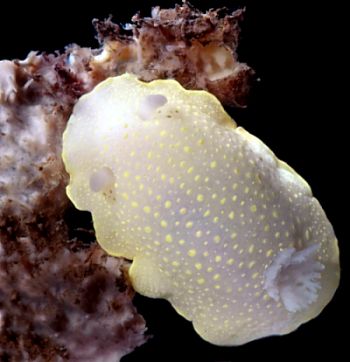
Cadlina luteomarginata
MacFarland, 1966
Order: NUDIBRANCHIA
Suborder: DORIDINA
Superfamily: EUDORIDOIDEA
Family: Chromodorididae
DISTRIBUTION
West Coast of Nth America from Alaska to Mexico.
PHOTO
Cape Arago, Oregon, USA. on food sponge Pleraplysilla sp. Photo: Jeff Goddard.
See Cadlina luteomarginata Radula Photos.
Cadlina luteomarginata is found on the west coast of North America from Mexico to Alaska (Behren's 1991). It is white with yellow capped tubercles, a yellow border to the mantle and the foot, and yellow tipped gills and rhinophores. The edges of the gill and rhinophore pockets are also lined with yellow. However, although the yellow border appears to be consistently present, it seems that any of the other yellow markings may be absent in particular individuals. Cadlina luteomarginata is reported to feed on a variety of spiculate sponges including Halichondria, Myxilla, and Higginsia. See Jeff Goddard's message below. [Cadlina luteomarginata MacFarland, 1966 is a replacement name for Cadlina marginata Macfarland, 1905, which for nomenclatural reasons is unavailable].
A similarly coloured species from the east coast of Nth America has been identified as Cadlina luteomarginata but there are consistent colour and food differences. See the Cadlina cf. luteomarginata Page.
References:
• MacFarland, F. M. (1966) Studies of opisthobranchiate mollusks of the Pacific coast of North America. Memoirs of the California Academy of Sciences, 6: 1-546.
• Rudman, W.B. (1984) The Chromodorididae (Opisthobranchia: Mollusca) of the Indo-West Pacific: a review of the genera. Zoological Journal of the Linnean Society, 81: 115-273.
Rudman, W.B., 2001 (August 22) Cadlina luteomarginata MacFarland, 1966. [In] Sea Slug Forum. Australian Museum, Sydney. Available from http://www.seaslugforum.net/find/cadllute
Related messages
Re: Acanthodoris hudsoni or Cadlina?
February 22, 2008
From: Marli Wakeling
Concerning message #21109:
This looks like Cadlina luteomarginata, rather than the furry looking Acanthodoris hudsoni. The photo in the new "Nudibranchs of the World" has a photo of Cadlina luteomarginata in place of Acanthodoris hudsoni, so not surprising there will be some misidentified critters out there.
Marli Wakeling
scubamarli@gmail.com
Wakeling, M., 2008 (Feb 22) Re: Acanthodoris hudsoni or Cadlina?. [Message in] Sea Slug Forum. Australian Museum, Sydney. Available from http://www.seaslugforum.net/find/21391Thanks Marli,
Seems to be a unanimous agreement for Cadlina luteomarginata
Best wishes,
Bill Rudman
Re: Acanthodoris hudsoni or Cadlina?
February 22, 2008
From: Brian K. Penney
Concerning message #21109:
Paul and Dave-
I would guess Cadlina luteomarginata: in the lower photo, many of the yellow dots look like they are under the skin, indicating they are chemical defense glands, or Mantle Dermal Formations (MDFs).
In my years in British Columbia (1997-2002), I found scaleworms in the mantle margins of the larger dorids with some frequency (I count almost thirty cases in my notes), including Cadlina luteomarginata. A labmate was an expert on polychaetes, and identified one scaleworm as an Arctonoe species, though I don't recall if it was A. vittata, A. fragilis, or other. A. vittata is a commensal on keyhole limpets and gumboot chitons, so it would make sense if it extended its reach to nudibranchs.
Locality: Barkley Sound, 0-15 m, British Columbia, Canada, Pacific Ocean, rocky, cobble
Best
Brian
bpenney@anselm.edu
Penney, B.K., 2008 (Feb 22) Re: Acanthodoris hudsoni or Cadlina?. [Message in] Sea Slug Forum. Australian Museum, Sydney. Available from http://www.seaslugforum.net/find/21390Thanks Brian,
From your comments and Leslie's [#21389], I think we have identified the worm but it looks like the nudibranch is the problem. From your comments and Dave's I think we should move it to Cadlina luteomarginata.
Best wishes,
Bill Rudman
Re: Acanthodoris hudsoni or Cadlina?
February 22, 2008
From: Leslie Harris
Concerning message #21109:
Hi Dave, Paul, and Bill --
The hitchhiker is a juvenile Arctonoe vittata. Since Jim Lyle brought nudi-riding worms to my & Bill's attention in 2005 (messages #14298 & #14447)I've seen several more cases so it's probably not uncommon - just unseen because they're small & fairly transparent. Arctonoe vittata, A. pulchra, and A. fragilis (probably the worm in message #14447) are all well known commensals but until Jim first photographed the association they were not reported to be on nudibranchs. There's usually only one adult Arctonoe per host. Small ones would be unable to compete with a adult so it makes sense that they would seek out smaller organisms as hosts.
Cheers,
Leslie
lharris@nhm.org
Harris, L.H., 2008 (Feb 22) Re: Acanthodoris hudsoni or Cadlina?. [Message in] Sea Slug Forum. Australian Museum, Sydney. Available from http://www.seaslugforum.net/find/21389Thanks Leslie,
I am so glad that we have a participant with broader interests than most of us. It is great to be able to get some background information on some of the many organisms that interact with sea slugs. The identity of the nudibranch is still somewhat tentative, and probably impossible to resolve just from photos, but on the basis of feedback from Dave Behrens and Brian Kenney I have moved it to Cadlina luteomarginata.
Best wishes,
Bill Rudman
Acanthodoris hudsoni or Cadlina?
February 19, 2008
From: Paul Sim
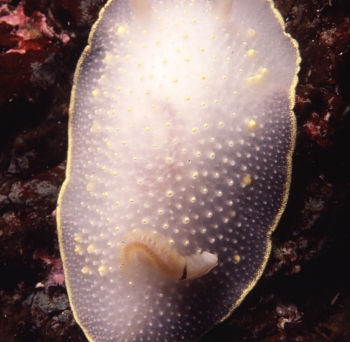
Hello Bill.
This is just a photo of Acanthodoris hudsoni for your perusal and interest. Nothing to ID unless you'd like to take a stab at that (I think) juvenile scale worm or perhaps share a thought as to what it's doing there.
Locality: Grouse Island, Johnstone Strait, 40 feet, British Columbia, Canada, Pacific, 08 October 2007, rock wall. Length: 1-1/2 inches. Photographer: Paul Sim.
Cheers,
Paul Sim
plsim@shaw.ca
Sim, P.D., 2008 (Feb 19) Acanthodoris hudsoni or Cadlina?. [Message in] Sea Slug Forum. Australian Museum, Sydney. Available from http://www.seaslugforum.net/find/21109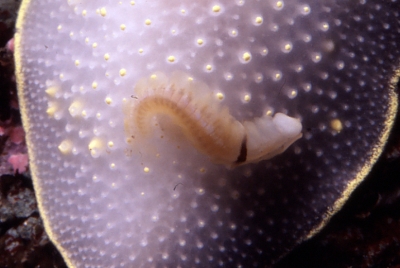
Hi Paul,
I wouldn't touch a scale worm ID with a ten foot poll. Just not my area of expertise. I am concerned that this may not be Acanthodoris however. Hard to tell from this helicopter shot, but the tubercles don't look tall and slender enough. Makes me wonder if this isn't Cadlina luteomarginata. Your thoughts are welcome.
Best regards,
Dave Behrens
Re: Cadlina? Aldisa? or . Conualevia alba?
August 4, 2007
From: Brian K. Penney
Concerning message #20176:
Hi Dave
I agree that it is often impossible to positively identify a species from a photograph alone. However, I thought I should point out that while I was in British Columbia, I collected a large number of individuals of Cadlina luteomarginata that had a mantle gland pattern and tubercle shape (smaller and almost coming to a low point, rather than broad and rounded) similar to that in Jackie and Glenn's photos. I checked their species identity using other characters (radula, etc.) so I am sure this was variability in one species rather than misidentification. I have sent some specimens on to Rebecca Johnson for her work on the genus, but I am not sure what she has found.
Locality: Bamfield, 0-15m, British Columbia, Canada, Northeast Pacific, 1997-2000, cobble-rocky substrate.
Also, at least several members of the genus Cadlina (C. flavomaculata, C. laevis, C. luteomarginata ) have spicules. See:
-
Alder, J., and A. Hancock. 1845-1855. A monograph of the British nudibranchiate Mollusca. The Ray Society, London.
-
MacFarland, F. M. 1966. Studies of Opisthobranch Mollusks of the Pacific Coast of North America. California Academy of Sciences, San Francisco.
-
Penney, B. K. 2006. Morphology and biological roles of spicule networks in Cadlina luteomarginata (Nudibranchia, Doridina). Invertebrate Biology 125:222-232.
Best wishes
Brian
bpenney@anselm.edu
Penney, B.K., 2007 (Aug 4) Re: Cadlina? Aldisa? or . Conualevia alba?. [Message in] Sea Slug Forum. Australian Museum, Sydney. Available from http://www.seaslugforum.net/find/20373Hi Brian,
Thanks so much for this excellent reply. We needed advice from someone who had looked at their internal anatomy.. Good show.
I must admit this is certainly a different color variation for this species then I have ever come across. Good information for a next edition of Eastern Pacific Nudibranchs.
Thanks for clearing up this ID,
Dave Behrens
Cadlina? Aldisa? or . Conualevia alba?
August 1, 2007
From: J. Hildering & G. Miller
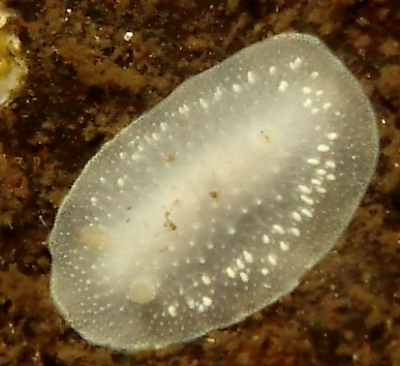
I really need help with this one. It has spots on the outer edge like Cadlina modesta but these are white as is the rim. I don't think Aldisa albomarginata has the white spots and these do not have the typical green tinge of this species. Of course, it is with great trepidation that I consider Conualevia alba as its reported range is only as far North as Carmel, California; these individuals were bigger and I did not find them under rocks. I could not discern if the rhinophores are in fact smooth. In short, to ID this one I need help and fear I might be missing the obvious.
Locality: Mist Island , 60', British Columbia, Canada, Pacific Ocean, 08 July 2007 , Wall . Length: 4 cm . Photographer: Jackie Hildering.
Jackie Hildering & Glen Miller
earthlingenterprises@telus.net
Hildering, J. & Miller, G., 2007 (Aug 1) Cadlina? Aldisa? or . Conualevia alba?. [Message in] Sea Slug Forum. Australian Museum, Sydney. Available from http://www.seaslugforum.net/find/20176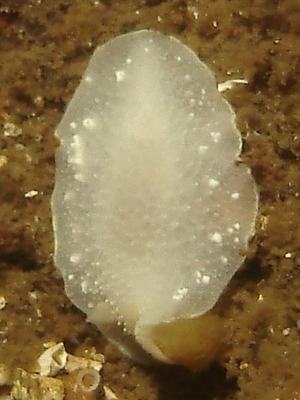
Hi Jackie and Glen,
Well as Bill and I have said so many times before, you cannot always identify a nudibranch from a photo alone. This one is certainly the case. I think we can eliminate Cadlina due to the shape of the dorsal tubercles, and what almost looks like spicules within the mantle. Conualevia is out as the rhinophores are not long and simple, but appear short and perfoliate to me. That leaves one of the species of Aldisa. I don't recognize it as either of the white species. Maybe we can have Jeff Goddard or Sandra Millen pipe in on this one.
Thanks for sharing,
Dave Behrens
Cadlina luteomarginata? being eaten by a seastar
July 10, 2007
From: Jackie Hildering and Glen Miller
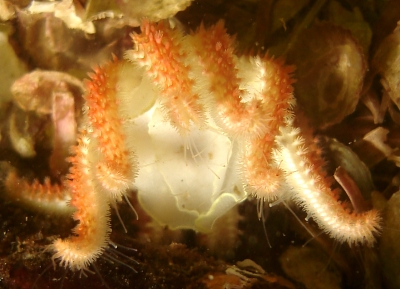
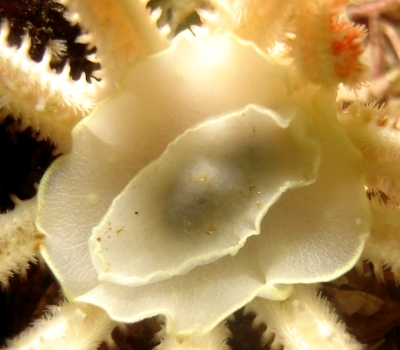
Thought it might be of interest to see what appears to be predation by a sun star (Solaster sp) on what I believe is an unfortunate Cadlina luteomarginata.
Locality: Xihwu Reef near the wreck of the Boeing 737, 35 feet, British Columbia, Canada, Pacific Ocean, 14 April 2007, Wall . Length: 2.5 cm. Photographer: Jackie Hildering.
Jackie Hildering
earthlingenterprises@telus.net
Hildering, J. & Miller, G., 2007 (Jul 10) Cadlina luteomarginata? being eaten by a seastar. [Message in] Sea Slug Forum. Australian Museum, Sydney. Available from http://www.seaslugforum.net/find/20125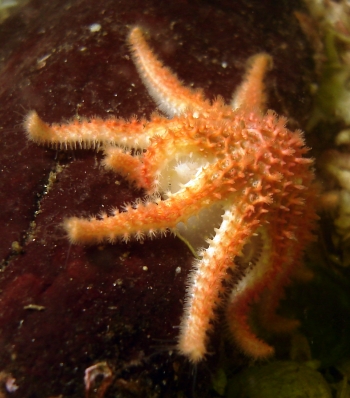
Dear Jackie and Glen,
Not sure if the dorid is a Cadlina or an Acanthodoris hudsoni, but never-the-less this is an interesting find. We don't often get to see predation on nudibranchs because of their excellent defensive system. This poor slug has unfortunately met up with one one of the nastiest predators in the Pacific Northwest. This star is a juvenile Solaster dawsoni, and known to be a voracious and not very selective feeder.
Thanks for sharing,
Dave Behrens
Acanthodoris hudsoni or Cadlina luteomarginata?
December 31, 2004
From: Peter McGuinness
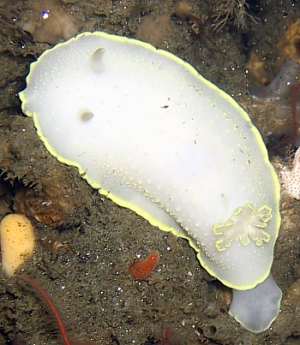
Bill,
Thanks for your reply [#12838] about Navanax. I noticed your query from last year about the colour of Acanthodoris hudsoni and also noticed no-one sent you a picture of a yellow fringed one, so here's one from my collection.
Funnily enough, this chap has yellow in all the right places except the rhinphores.
Locality: Scripps Canyon, (North Branch) San Diego, California, USA.
Depth: 100 ft. Length: ? 6 September 2004, on vertical canyon wall
Photographer: Peter McGuinness
Cheers,
Peter
pmcguinness@sbcglobal.net
McGuinness, P., 2004 (Dec 31) Acanthodoris hudsoni or Cadlina luteomarginata?. [Message in] Sea Slug Forum. Australian Museum, Sydney. Available from http://www.seaslugforum.net/find/12858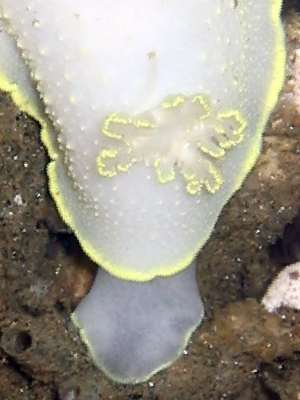
Dear Peter,
Thanks for the interesting photo. I suspect it is not Acanthodoris hudsoni. The rhinophores don't seem long enough and the shape of the gills doesn't look quite right. I suspect it is one of the animals at present called Cadlina luteomarginata, but you will see from my comments under that species that it is possible that there is more than one species. See Rebecca Johnson's message [#5163] for example. I look forward to some comments from Californian residents, who should have a better idea than me on the other side of the Pacific.
Best wishes,
Bill Rudman
Cadlina luteomarginata from California
August 3, 2004
From: Bruce Wight
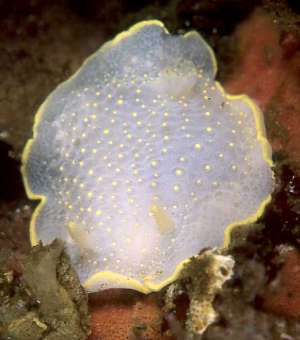
Hi Bill,
Here is a photo of Cadlina luteomarginata from San Miguel Island, Channel Ids, California I took over the weekend [July 2004] with the SDUPS.
Bruce Wight
bruce.c.wight@boeing.com
Wight, B.C., 2004 (Aug 3) Cadlina luteomarginata from California. [Message in] Sea Slug Forum. Australian Museum, Sydney. Available from http://www.seaslugforum.net/find/12722Thanks Bruce,
Bill Rudman
The identity of Cadlina luteomarginata
August 30, 2001
From: Rebecca Johnson
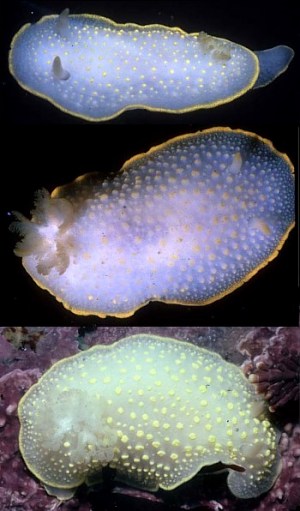
Hi Bill,
I have been enjoying the discussion about Cadlina laevis and Cadlina luteomarginata. I have finally had a minute to get my thoughts and slides together. As Brian mentioned I am working on a phylogeny of basal Chromodorids including Cadlina, Cadlinella and Tyrinna. I am hoping to better understand the relationships of these groups by using morphological and molecular characters in a phylogenetic analysis. I am also planning to do some population genetic work on Cadlina luteomarginata, so this dicussion is very timely. In the UPPER RIGHT photo are some pictures I culled from the slide collection of the Californian Academy of Sciences. They are all Cadlina luteomarginata. The TOP one is from somewhere in central California. It has yellow on its gills and rhinophores and tubercles but not on the mantle glands, which are white and visible through the mantle. The MIDDLE one is from Cannery Row, Monterey, California and has yellow on its gills, rhinophores and tubercles, but the glands are not visible. The BOTTOM one is from Duxbury Reef in Marin County, California and does not have white on its gills or rhinophores and you can not see any mantle glands. (This looks a lot like Jeff's photo.)
In MacFarland's original drawing you can see the yellow on the rhinos and gills, just like in the two top animals. So, I don't know how "important" this character is ... but if it is consistent with some other characters .. then maybe we are on to something. This possibility got me thinking about some photos I took this summer with our undergraduate intern, Davi Almeida. We found variation in the radulae of Cadlina luteomarginata. I only have a photo from one specimen LOWER RIGHT (I will send more soon and I will send a reproductive drawing too!) but you can see that this rachidian differs from that described by MacFarland and illustrated at LOWER LEFT.
Unfortunately, I do not know if this specimen had yellow on its gills and rhinophores. We were looking at some older lots because they had more than one specimen, and the animals were pretty large in size (good for disection practice), but they don't include slides. This is a good example of why photos are so important even for relatively well studied species.
So, I hope someone has some insight ... or at least this will start someone thinking as the previous messages did me.
On another note, I would really like to look at the Cadlina sp. from New England. If anyone would like to send me specimens (or just a piece of the foot will work) in 95% EtOH for molecular and Bouin's or formalin fixed for morphology (the rest of the animal), along with photos I would be happy to help get to the bottom of this mystery.
Thanks and take care,
Rebecca
rjohnson@calacademy.org
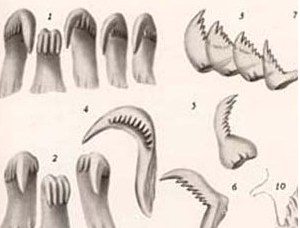
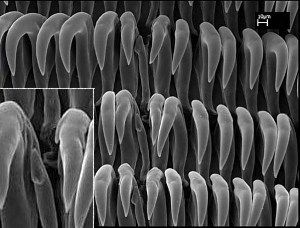
Dear Rebecca,
Thanks for your thoughts. If your planning some population genetics on C. luteomarginata I would say it was pretty important to know whether you had one or two species mixed up in your populations. Since I am so far away, I am in the perfect position to make judgements on the Californian fauna. Jokes aside, if that radula in your SEM photo belongs to the Cadlina without yellow on the gills and rhinophores I would say you may have two species. As you would well know every now and then an animal has a peculiar aberrant radula, so you will need to do a few more. MacFarland's radula drawing differs not only in the shape of the central tooth but also in the shape and denticulation of the laterals. I have added some SEM photos of the radula of what I presume is C. luteomarginata which I published some time ago. They certainly look more like MacFarland's than yours, with distinctive denticulation on all the teeth, and a shorter, wider central tooth. It is certainly an interesting project and I look forward to hearing what you discover.
Best wishes,
Bill Rudman
Re: Cadlina luteomarginata
August 25, 2001
From: Brian K. Penney
My animal certainly looks similar to Cadlina luteomarginata, and more so than the few Cadlina laevis I have seen. I have seen some specimens that look similarly translucent and with prominent mantle glands (especially if small) here in British Columbia, Canada. However, I rarely see C. luteomarginata with yellow-tipped gills; normally they look like Jeff Goddard's photo.
Is someone able to collect some east coast specimens to send to Rebecca Johnson at California Academy of Sciences, who is currently working on Cadlina phylogeny? (feel free to pipe in here, Rebecca) She would need some preserved in formalin and some in 95% ethanol for morphological and molecular work, respectively.
Best regards,
Brian
bpenney@ualberta.ca
Penney, B.K., 2001 (Aug 25) Re: Cadlina luteomarginata. [Message in] Sea Slug Forum. Australian Museum, Sydney. Available from http://www.seaslugforum.net/find/5146Dear Brian,
I was wondering how important the yellow tipped gills and rhinophores were in Cadlina luteomarginata. They are certainly present in the photo in Dave Behren's book, and mentioned in MacFarland's original description, but clearly absent in Jeff Goddard's photo.
best wishes,
Bill Rudman
Cadlina luteomarginata from Oregon
August 24, 2001
From: Jeff Goddard

Hi Bill,
Here is some information on Cadlina luteomarginata from the west coast of North America that may help clear up the identity of Paul Young's Cadlina from New England.
Cadlina luteomarginata from the Pacific always have a dorsum with a yellow border and yellow-capped papillae. The background white is quite opaque, and I have never noticed the deep-set, yellow defensive glands so obvious in Paul Young's and Bernard Picton's photos of Cadlina laevis.
Cadlina luteomarginata from Cape Arago, Oregon feed on at least 13 species of spiculate sponges, primarily Zygherpe hyaloderma, Hymendectyon lyoni, Myxilla incrustans and Hymedesmia sp. However, the largest number of individuals are found feeding on the dendroceratids Aplysilla glacialis and Pleraplysilla sp. (personal observations). I have never found C. luteomarginata feeding on Halisarca. At Cape Arago, Halisarca is the sole prey of Hallaxa chani. Cadlina modesta also preys on Halisarca, but is more commonly found preying on Aplysilla glacialis. Y-maze trials show that C. modesta prefers the latter over the former (personal observations), and I have never found C. modesta feeding on any other sponges or seen sponge spicules in its gut.
The radular morphology of the above species appears to reflect their diets. Cadlina luteomarginata has strongly hooked lateral teeth, while both Hallaxa chani and Cadlina modesta have nearly straight, saw-like laterals. According to the illustrations in Thompson & Brown (1984), C. laevis, which specializes on Halisarca thoughout much of its range, has lateral teeth very similar to those of C. modesta and Hallaxa. I agree with you and Bernard Picton in identifying the sponge in Paul Young's photos as a 'slime sponge', probably Halisarca. Therefore, I think that his specimens are a color form of Cadlina laevis or an undescribed species. I doubt they are C. luteomarginata.
I have attached an old photo of mine of Cadlina luteomarginata on Pleraplysilla sp. from Cape Arago, Oregon. Hopefully, someone will send in a better, in situ photo of this striking species.
Best wishes,
Jeff Goddard
goddard@lifesci.ucsb.edu
Goddard, J., 2001 (Aug 24) Cadlina luteomarginata from Oregon. [Message in] Sea Slug Forum. Australian Museum, Sydney. Available from http://www.seaslugforum.net/find/4894Dear Jeff,
Thanks for this information.
Best wishes,
Bill Rudman.
Dorid feeding in captivity
August 24, 2001
From: Brian K. Penney
Hi Bill,
A question for the Forum: has anyone had much luck feeding Cadlina luteomarginata or related species in captivity? I have been trying recently without much luck, and I see in Steve Bloom's thesis (1976, University of Washington) he tried feeding experiments with this species but never reports them.
I am reasonably sure I have the correct sponge for food – we often find Cadlina on Aplysilla glacialis, and fecal samples suggest that is what these individuals were eating before capture. The sponge is freshly collected and in good condition. Also, several other species (Anisodoris nobilis, Archidoris montereyensis) are not feeding as enthusiastically as I have seen them do elsewhere. Therefore lab conditions seem a likely suspect. I have tried changing flow regimes and oxygen levels with no luck. Any advice on what else to vary?
Hope all is well down under. Sorry to all those I missed at the WSM meeting: I'll be free to come out again next April when my dissertation is complete!
Cheers,
Brian
bpenney@ualberta.ca
Penney, B.K., 2001 (Aug 24) Dorid feeding in captivity. [Message in] Sea Slug Forum. Australian Museum, Sydney. Available from http://www.seaslugforum.net/find/5112Dear Brian,
In theory, if you have the right sponge and its fresh and healthy you should have no problem. However that's easy to say and often the most dedicated and diligent attempts fail - while another time when you don't really care and don't try very hard, success is unlimited! I think the hardest thing is keeping the sponge colony healthy. Sponges are bags of nasty chemicals which are just waiting to be released at the slightest disturbance. As you are probably well aware, a sick sponge can quickly poison an aquarium. When you consider that you are attempting to keep a sponge alive and healthy while it is being eaten alive by a nudibranch, it is no wonder that there are many failures.
Good Luck,
Sorry I don't have any secret answers,
Bill Rudman
